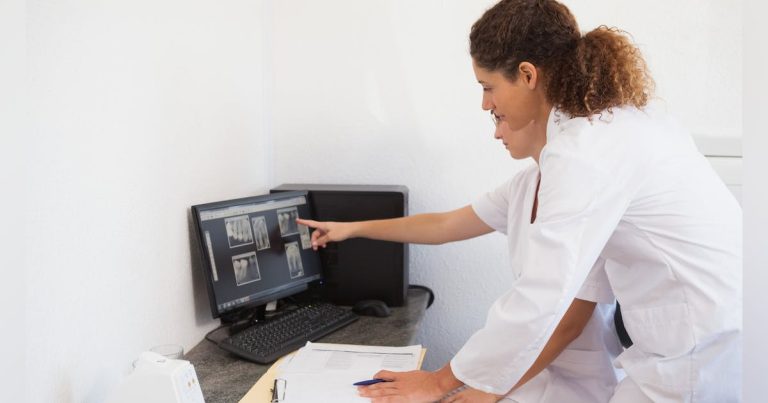Dental technology is constantly evolving, which means patient care techniques are also changing. While it can be daunting to keep everything straight, there are tools to ensure you are up to date with the most important innovations.
In addition to allowing you to provide the best possible patient care, staying informed about dental technology can help you avoid billing errors and make you a more marketable dental practice candidate. Here are some of the more important updates to keep in mind.
Consult the source of truth
Each year, the American Dental Association (ADA) publishes the Code of Dental Procedures and Nomenclature, otherwise known as the CDT code, containing the most up-to-date terminology for dental services. This terminology is used to make accurate claims to insurers. The CDT is revised annually and is available as a book, e-book or mobile app. The companion coding book is accompanied by case studies using multiple codes for patient scenarios to demonstrate how the various procedure codes can and should be used.
Each dental procedure code entry in the CDT code is marked with five alphanumeric characters and begins with the letter D. This is followed by the procedure code followed by the nomenclature, which is the title of the procedure. Some entries also contain a descriptor, which is a brief narrative explaining the use of a given code and is required when a CDT code includes the phrase “by reference.”
The CDT code is divided into service categories for easy navigation. Given how important it is to submit the correct procedure codes for billing and insurance claims, always consult the codebook when in doubt.
You may also want to watch: Can I bill medical insurance for this?
Familiarize yourself with these procedure codes
There are certain procedures that hygienists perform regularly. The codes for these procedures deserve special attention and familiarity. Here is a summary of the codes hygienists should keep in mind.
In 2021, there was an update to the code D1110 which includes the removal of plaque, calculus and stains from tooth surfaces and implants. This procedure is intended to control irritants and is a preventive rather than a curative procedure.
Code D4346 is for “escalation in the presence of generalized moderate or severe gingival inflammation.” This is a full-mouth code used in the treatment of gum disease in the absence of clinical attachment loss. If there is radiographic evidence of bone loss, this is not the appropriate code to use.
The code D4355 is the “full body cleaning to enable a comprehensive periodontal assessment and diagnosis at a subsequent visit”,1 and is becoming less popular for a few reasons. Patients often do not return for proper evaluation and diagnosis because they believe they received the proper cleaning and do not understand that a comprehensive exam was not completed. Today, digital radiographs and AI-powered image interpretation applications facilitate the detection of clinical attachment loss in the absence of the holostomy catheter on initial examination. However, it is still necessary to complete a comprehensive periodontal chart and this can be done at the same visit as periodontal scaling. Simply increase the appointment time to include the assessment.
Keep in mind codes D4341 and D4342. There are cases in which a patient can have generalized gingivitis and localized periodontitis. Documentation should include the presence of active disease and should state which teeth or quadrant received root planing. The number of teeth with active periodontal infection, radiographic bone loss, or clinical attachment loss will determine whether the patient needs D4341 or D4342 in each quadrant.
I am using code D4910 Regarding periodontal maintenance, there must be evidence that previous active treatment, such as scaling and root planing, has been completed. Because periodontal disease is episodic in nature, long-term management of the disease may require active treatment when the disease is active. As stated in the period maintenance code description, periodic maintenance allows for “site-specific scaling and root planing where indicated.” This is the main difference between a prophylactic cleaning and a periodontal maintenance. Explaining this to patients will help them understand the difference because they often ask why they can’t go back to “regular cleanings”.
Code D6080 used when a fixed implant-supported prosthesis is removed to clean both the prosthesis and supporting implants. The procedure involves cleaning and examining all aspects of the implant system, including occlusion and fitting of the prosthesis or prostheses. This code is used per appointment, not per addition.
After all, code D6081 is an implant code used when there is inflammation or mucositis associated with a single implant. This is one code per implant and requires a supporting narrative, along with x-rays and pocket mapping when submitting for insurance reimbursement.
It is important to note that if the patient’s insurance does not provide coverage for implants, there will likely not be coverage for implant maintenance.
Knowing your passwords has significant benefits
Knowing your codes can help your dental office avoid billing errors, potential write-offs, and unhappy patients. The codes discussed here are just a small portion of all the procedure codes you may run at some point during your sanitation career. However, understanding some of the more common or difficult codes can make your job and the overall patient experience much smoother. Hygienists are lifelong learners, so following the CDT codes is an important part of your learning journey.
Report
1. CDT 2023 Codebook

